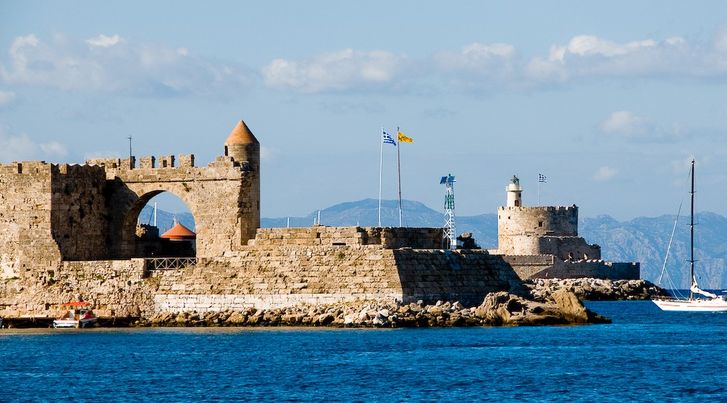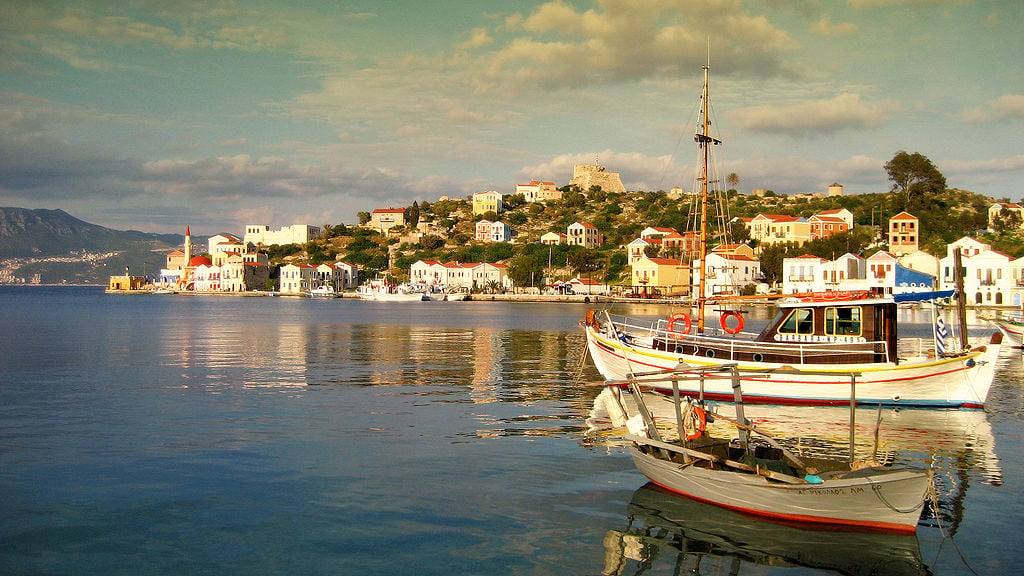
By Jennifer Barclay
Among the stone shells of houses in Paleo Pyli, high among the pines and cypresses on Mt. Dikeos, which dominates Kos, nothing stirs the silence except a trickling stream and a few grazing goats.
But something catches my eye: two smooth domes in the roof of a low building, and a tree growing through the middle. Ducking inside to find waterspouts in the walls and circular holes in the domes to let in light, I realize it was a Turkish bath.
Kos was part of the Ottoman Empire when the village was deserted 200 years ago.
The abandoned places, and these traces of lost ways of life of the Dodecanese, have been my obsession for several years. It’s almost a decade since I moved to the little island of Tilos in this group of islands in the South Aegean, close to the shores of Turkey, for the rugged landscape, the welcoming rural community, the wild emptiness and the climate, which is perfect for adventurous walking and swimming.
Wherever I walk, far away from the last bit of road, are dry-stone terrace walls that leveled the steep mountains for cultivation; huts with fireplaces still intact because they knew how to make them last by placing the stones a certain way; threshing circles and broken pottery.
When people traveled by donkey and boat, many of the places where I find myself exhilaratingly alone were thronging with people. There is so much more to explore than we realize, especially in places where building has been limited: endless intriguing objects and ruins left behind that illustrate the islands’ history.
In the Dodecanese the road to independence was longer
While on March 25, Greece celebrates 200 years since the uprising against centuries of Ottoman rule, here in the Dodecanese the road to independence was longer, with more twists and turns.
The islands had become part of the Ottoman Empire in 1522 after a long siege. In the town of Rhodes, it’s impossible to miss the minarets, including that of the beautiful Murad Reis Mosque close to the ancient harbor, with its Turkish cemetery.
The Old Town has enclosed wooden balconies, a hammam, and fountains — all Ottoman.
Kos is the second largest island in the group, its town enclosed by two peninsulas of Turkey, and it too became heavily subjected to Ottoman influence, though many of these traces were later destroyed. In Pyli is a fountain built in 1592, still flowing.
The smaller islands mostly surrendered to the Turkish invaders, however, and in return were designated ‘Privileged Islands’: allowed to retain their language, religion, and self-sufficient way of life as long as they paid their taxes.
Kalymnos continued to derive its wealth from fishing for and trading in sponges, which seemed implausible until I found out sponges were used for such diverse purposes as filtration and contraception.
Symi supplied sponges and bread to the Turkish mainland, and thrived on shipbuilding, wine production and its merchant fleet. On some islands, there’s barely any evidence of the Ottoman occupation except in words and cuisine.
On Tilos, in hillside chapels you find the scratched-out eyes of saints in frescoes, thought to be the result of Muslim iconoclasts.
Mostly left to their own devices, many islands prospered. Perhaps the most extreme example is Kastellorizo, just twelve square kilometers of rock situated two kilometers off the southern shores of Turkey and over 125 km east of Rhodes, its nearest Greek neighbor.
In the nineteenth century, it benefitted from access to raw materials and markets among Greek communities in Asia Minor (Smyrna and Constantinople) and became one of the great shipping centers of the Mediterranean. Kasos, the southernmost of the Dodecanese islands, at that time had a population nearing 13,000, a thriving ship-building industry and a large merchant shipping fleet.
Dodecanese on the front lines in 1821
In March 1821, Greeks all over the country took up arms against the Ottoman overlords, and the Dodecanese were on the front line. Inspired to become part of a new Greek state, their role in the uprising that became the Greek War of Independence was prominent and heroic.
Kasos took a bold stand, converting its fleet for use as a Navy, sheltering Cretan freedom fighters and making raids on Asia Minor. They were enough of a thorn in the Ottoman side that the sultan finally asked his allies to get rid of the problem.
In 1824, the Egyptian Navy under Ibrahim Pasha besieged Kasos, massacred all the men they could find of fighting age, sold the women and children into slavery, and set fire to the island.
The war was eventually successful: in 1830, Britain, France and Russia formulated the London Protocol recognizing Greece as an independent state. And yet, they excluded the Dodecanese which, as a bargaining chip, were given back to the Ottoman Empire. For most of the islands it was a devastating blow.
In Kasos, those who escaped the 1824 catastrophe either returned to rebuild after the war, continuing their nautical traditions, or left – for Egypt to build the Suez Canal, or for London and New York and Canberra. The “poet of the sea,” D.I. Antoniou, was born in 1906 to a great Kasiot shipping family in Mozambique.
For several generations, these islands were entangled in other people’s wars and oppressed by occupiers. A series of natural disasters compounded the suffering – a terrible earthquake, a year or two without rain. As opportunities burgeoned elsewhere, people began to leave.
Emigration from the Dodecanese
Communities from across the Dodecanese began to grow in Baltimore and Tarpon Springs, Darwin and Fremantle, St. Petersburg and Gweru. The islands eventually gained their independence and became part of Greece after the Second World War – by which time they were already half-deserted.
The emigration and desertion had a positive side, however. Most importantly, they allowed the people to flourish safely elsewhere. But secondly, they created the havens of peace and calm we know and love today: the rugged, unspoiled coasts and hills that are conservation zones for seals and eagles, refuges from the noise and overbuilding and pollution of contemporary life.
Windswept Kasos is now an island of quiet villages, dramatic hills where you can hike for hours without seeing a soul, tiny beaches and picturesque harbours. After summer visitors leave, the thousand islanders go back to fishing, cheese-making and beekeeping.
In the hillside neighbourhood of Panayia, among the broken stone walls of abandoned dwellings are captains’ houses, still showing herringboned wooden ceilings and hand-painted walls, their empty windows looking out to sea.
In pretty Kastellorizo, meanwhile, neoclassical mansions painted blue, yellow and green line the exquisite natural harbour, stark against white karst hillsides, pine-covered slopes and imposing limestone cliffs.

The island offers calm in an idyllic Mediterraneo setting; water taxis flit from islets to the famed Blue Cave and from the water’s edge fringed with tavernas. But behind the waterfront, many houses are still ruined, bare walls punctuated by holes for wooden beams long gone, intimate domestic details such as wooden shelves and part of a dresser exposed to the elements, handwritten signs with a name claiming ownership.
At the mouth of the harbour is the mosque, now a museum telling the island’s history.
When Kastellorizo was returned to Ottoman rule in 1830, it had protection and a trading partner again. By the end of the nineteenth century it was an affluent town with a population of more than 8,500, magnificent churches and even a girls’ school. But the twentieth century brought a series of calamities, not least the population exchanges and being caught in the crossfire of wars.
The island now has just two to three hundred residents, with a very erratic water supply (“I’ve drunk bottled water since the day I was born!” said one resident). The Kastellorizian Association of Victoria, Australia has some 30,000 persons.
At dawn, the sun rises over the mountains of Turkey, creating a strange illusion: a gleaming bridge of light linking the mainland with Kastellorizo. I scramble up the rocky hillside to a plateau where I find old stone farmhouses, stone walls and water cisterns still functional but abandoned. When I turn back towards the town, I look down at and see all the empty spaces still criss-crossed with the remains of houses. The bridge of sunlight to the mainland has broken up again, shimmering silver.
Jennifer Barclay is the author of several books about Greece including Wild Abandon: A Journey to the Deserted Places of the Dodecanese.

See all the latest news from Greece and the world at Greekreporter.com. Contact our newsroom to report an update or send your story, photos and videos. Follow GR on Google News and subscribe here to our daily email!



